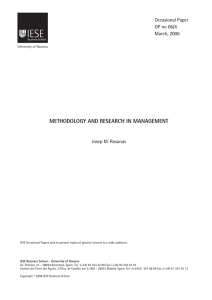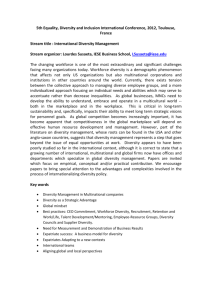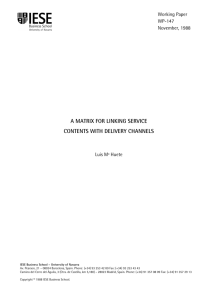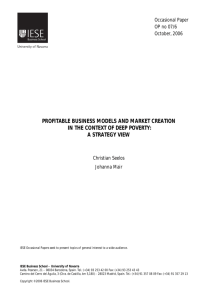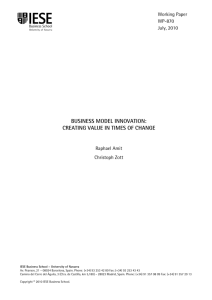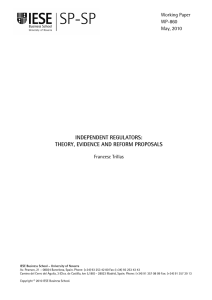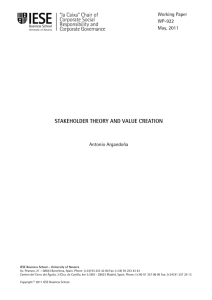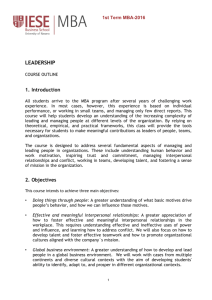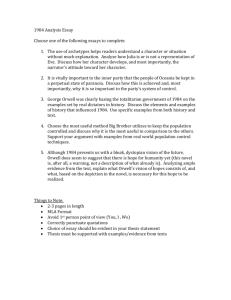linking manufacturing capabilities with sbu strategic directions
advertisement
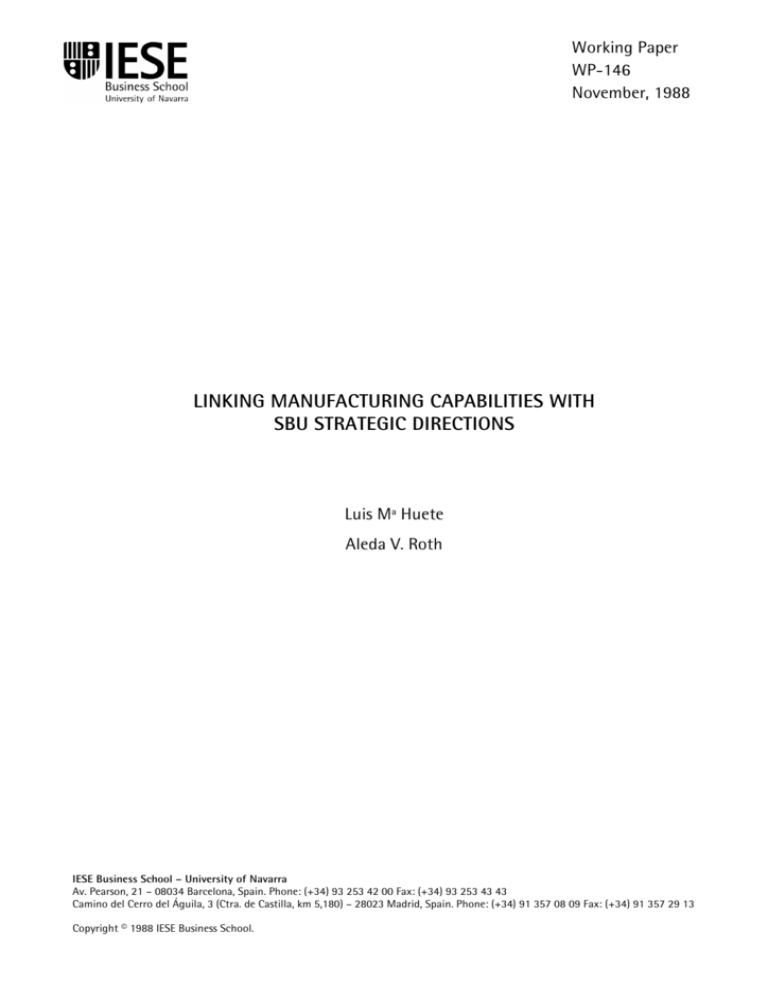
Working Paper WP-146 November, 1988 LINKING MANUFACTURING CAPABILITIES WITH SBU STRATEGIC DIRECTIONS Luis Mª Huete Aleda V. Roth IESE Business School – University of Navarra Av. Pearson, 21 – 08034 Barcelona, Spain. Phone: (+34) 93 253 42 00 Fax: (+34) 93 253 43 43 Camino del Cerro del Águila, 3 (Ctra. de Castilla, km 5,180) – 28023 Madrid, Spain. Phone: (+34) 91 357 08 09 Fax: (+34) 91 357 29 13 Copyright © 1988 IESE Business School. IESE Business School-University of Navarra - 1 LINKING MANUFACTURING CAPABILITIES WITH SBU STRATEGIC DIRECTIONS Luis Mª Huete1 Aleda V. Roth2 Abstract This paper presents the results of a study exploring the relationship between strategic policy options and broad-based manufacturing competitive capabilities. The results represent the views of 213 managers on the manufacturing capabilities and strategic directions of their own business units. The findings indicate several relationships between the two conceptual domains. Among the various types of manufacturing capability, flexibility emerged as the most potent predictor of strategic directions. Note: Paper presented to the Operations Management Area of the Annual Meeting of the Decision Sciences Institute. Boston, November 23-25, 1987. 1 2 Professor of Production, Technology and Operations Management, lESE. Professor, Boston University. IESE Business School-University of Navarra LINKING MANUFACTURING CAPABILITIES WITH SBU STRATEGIC DIRECTIONS Introduction 1 In the last several years the business community has shown a renewed interest in manufacturing and its potential for contributing to the overall distinctive competence of a company. The literature refers to this phenomenon as the “back to manufacturing movement" (Skinner, 1985). Skinner’s earlier work (1978), his most recent publication (Skinner, 1985), and the work by Hill (1985), Hax and Fine (1985), and in particular the publication by Hayes and Wheelwright (1984), suggest that manufacturing constitutes a formidable competitive weapon if equipped and managed properly, and that the key to this consists of developing a coherent manufacturing strategy. The primary purpose of this research is to explore the linkages between competitive capabilities emphasized in manufacturing and the overall strategic policy emphasized by the strategic business unit (SBU). This issue is of growing interest for practitioners, but is not adequately addressed in either strategic or manufacturing literature. The study involved obtaining retrospective data from 213 strategic-level managers. Although the word “strategy" is used by managers in a variety of settings, (predominantly corporate, business unit, and functional area), and has a wide range of connotations in the academic literature, most definitions of strategy include elements such as establishing purpose or mission, setting direction, formulating plans, taking actions and securing a distinctive competence. The strategic setting which this paper addresses is a “business unit." As noted by others (Chandler, 1966), many United States corporations have moved to an organizational structure composed of several business units, each with its own business strategy. Planning units have been widely used since the early 1970s, when portfolio planning systems were adopted by American corporations. These planning units are defined in terms of strategic needs and opportunities, and are typically subdivisions of the traditional product divisions that make up most large corporations. This 1 The authors are grateful to Professors Jeffrey Miller and Tom Vollmann for the use of the 1984 Manufacturing Roundtable Data Base, Boston University School of Management. IESE Business School-University of Navarra research employs data from manufacturing business units obtained from the Boston University 1984 Manufacturing Futures Survey (Miller and Vollmann, 1984). A business unit, according to the survey definition, is a subsidiary, division, or product line of a company (depending on the way the firm is organized) that: a) produces a well-defined set of related products; b) serves a clearly-defined set of customers, and c) competes with a welldefined set of competitors. According to this notion, a business unit is the smallest subdivision of a company for which it would be sensible to develop a separate strategy. It provides as a unit of analysis, therefore, a framework with which to explore the relationships between strategic policy options and broad-based manufacturing competitive capabilities. Strategy at the business unit level normally specifies not only the set of products to be produced, customers to be served and competitors to be confronted but also the basis on which the business unit will achieve a sustainable distinctive competence (here referred to as a competitive priority). Porter (1980) cites certain notable competitive priorities by which the firm may obtain a competitive advantage. For example, price (often synonymous with cost leadership) is a common competitive strategy. Another generic competitive strategy is differentiation in the marketplace. Differentiation strategies focus on such factors as quality (defined by product performance, product reliability, and after-sales services), dependability (denoted by delivery promises, and fast deliveries), and flexibility (corresponding to product flexibility and/or volume flexibility). The classic strategic literature suggests that once a business unit has developed its business strategy, each functional area of the business should develop functional strategies that are congruent with the established business unit’s competitive priorities. The functional strategy specifies the resources required to obtain the necessary capabilities which support the global business unit strategy. Thus, it is left to manufacturing as a functional area to translate competitive priorities into sets of manufacturing capabilities and to assess which capabilities are critical for attaining the business unit priorities. Miller and Graham (1981) argue that operations policy involves translating corporate strategy “into the wealth of choices that defines the operation" and present a table showing the demands that can be placed on the operations function. As will be shown later in this paper, all these demands (cost of production, product performance, product reliability and workmanship, speed of delivery, delivery reliability, product customization, new-product introduction and volume flexibility) are the translation, in terms of the operations function, of almost identically labeled competitive priorities. Manufacturing strategy, then, is designed to fit the needs of the business on each of the salient manufacturing strategic decision variables, and strives for consistency between internal capabilities and the business unit's competitive posture. Hayes and Wheelwright (1984) mentioned eight strategic decision categories where competitive priorities can be operationalized in the manufacturing function. The first four are categorized as structural, the other four as infrastructural. They are: capacity (amount, timing, type), facilities (size, location, specialization), technology (equipment, automation, linkages), vertical integration (direction, extent, balance), workforce (skill level, wage policies, employment security), quality (defect prevention, monitoring, intervention), product planning/material control (sourcing policies, centralization, decision rules), and organization (structure, control/reward systems, role of staff groups). A key assumption which underlies most manufacturing strategy models (Skinner, 1969; Hayes and Wheelwright, 1984) is that a factory can only be designed to do a very few things very 2 - IESE Business School-University of Navarra well. Therefore, implicit relationships should exist between developing competitive capabilities, in terms of cost, delivery, quality, flexibility and developing focused strategic activities. The analysis that follows is composed of four distinct but interrelated parts. First we examine the correlations between variables relating to manufacturing capabilities and strategic directions. In the second part, we use factor analysis to reduce from sixteen to eight the number of variables measuring capabilities and directions. We show that the derived structures exhibit a high degree of factor loading stability across two randomly determined subsamples. Third, the subsamples are pooled and the factor analysis results are described. Fourth, we use a series of regression models to test the relationship between manufacturing priorities and business unit strategic directions. It is left for future research to empirically link the degree of observed congruence between manufacturing capabilities and the business unit's strategic directions with relative performance measures. Methods Sample The business unit data were obtained from the 1984 North American Manufacturing Futures Project (MFP) Survey. Mail questionnaires are sent annually to top manufacturing executives (typically vice-presidents or directors of manufacturing) in order to gather information on factors influencing manufacturing operations. A complete description of the survey and detailed item by item responses can be found in Miller and Vollmann (1984). In 1984, the survey was mailed to over 1,000 executives of large manufacturing business units in the United States and Canada; the respondents represented 213 business units. The survey included at least one business unit from each industrial company on the Fortune 500 list, as well as business units in firms participating in earlier surveys. Participating business units came from a broad range of industries, which were grouped into five categories: electronics, consumer packaged goods, machinery, basic industrial manufactures (chemicals, metals, paper), and other industrial goods. Median sales for the firms represented stood at $200 million, and median operating assets at $135 million. Our analysis has shown that the survey respondents are typical of large American manufacturers in most respects. The most notable bias is the unusually large percentage of successful business units represented. Measures The 1984 Manufacturing Futures Project survey instrument contained more than 50 multiplepart questions. Respondents' opinions concerning competitive priorities were surveyed as follows. Respondents were given a list of eight competitive capabilities and were asked to rank these capabilities in order of their importance for the business unit's competitive success over the next five years. Responses were recorded on a 5-point Likert-type scale ranging from “1", representing “no effect" to “5", representing “very critical". To survey strategic policy, the questionnaire presented the respondents with a list of strategic policy directions, and asked them to indicate what emphasis their business unit planned to give to each of these directions over the next five years. The response “1" corresponded to “no IESE Business School-University of Navarra - 3 emphasis" and the response “5" indicated “critical emphasis". The individual variables are shown in Table 1. Table 1 Individual Variables Manufacturing Capabilities Strategic Directions Ability to offer low price Increasing market share in existing markets Ability to make rapid design changes or introduce new products quickly Entering new markets with existing products Ability to make rapid volume changes Withdrawing from certain businesses Ability to offer consistent quality (reliability) Developing new products for existing markets Ability to provide high performance products Developing new products for new markets Ability to provide fast deliveries Growth by acquisition Ability to make dependable delivery promises Forward integration Ability to provide after-sale service Backward integration Analysis Exhibit 1 presents correlations of manufacturing capabilities and strategic directions. These correlations indicate the degree of covariance between categories: the likelihood that a SBU assigning a high or low score to one category has assigned a similar score to another category. Several findings are especially noteworthy in Exhibit 1. The emphasis that manufacturing managers attributed to after-sale services has a significant positive correlation with all other manufacturing capabilities, except with the ability to become a low cost producer. Manufacturing capabilities which are conceptually close – for example, fast deliveries and dependable deliveries, or quality-reliability and quality-performance – have a positive correlation. A similar positive correlation is noted among strategic directions: forward and backward integration correlate positively with acquisitions, as do new products for existing markets and new products for new markets. The strong relationships that exist between individual variables of manufacturing capabilities and strategic directions denote that variables within these conceptual domains are not independent. These findings tentatively suggest that manufacturing managers may be using a framework for organizing their thoughts about manufacturing capabilities and strategic directions with fewer variables than those used in the survey. Of greater interest is the correlation among manufacturing capabilities and strategic directions. The emphasis that a SBU placed on developing a low cost manufacturing capability has a negative correlation with the emphasis it placed on the strategic direction of developing new products for existing markets. By contrast, the emphasis that a SBU attributed to quality (performance) and after-sale service as manufacturing capabilities has a significant positive correlation with the emphasis it placed on the strategic directions of new products for existing or new markets. North American manufacturing managers appear to view the manufacturing capability “becoming a low cost producer" as incompatible with a strategic direction “developing new products for new markets" that places a strong commitment on innovation. This trait is a 4 - IESE Business School-University of Navarra basic assumption of lifecycle models (Utterback and Abernathy, 1975) and is similar to the one reported by Abernathy (1977) in his longitudinal study of Ford Motor Company. To further explore these correlations, the sample of 213 business units was randomly split into two subgroups. Separate principal component analyses were performed on each subgroup for both conceptual domains (competitive priorities and strategic directions). The purpose of this analysis was to reduce the sets of variables within each conceptual domain to a smaller number of mutually independent underlying factors. Principal component analysis produces meaningful descriptive matrices which aid in detecting underlying patterns or conceptual domains among a set of variables. Principal component analyses were performed using the inter-item Pearson correlation coefficient matrices (see Exhibit 1). Data were initially factored using the principal axis method followed by a Varimax rotation. The Kasier Eigenvalue-one criterion (Rummel, 1970) was first employed to locate the possible cut-off range in the number of factors to be selected. The Scree test (Cattell, 1966) served as an auxiliary guide in the final selection of factors. In accordance with these criteria, four factors were derived from the original eight manufacturing capabilities variables for each subsample. To determine the factorial reliability of these subsample results, congruence coefficients (Harman, 1967) were computed for each factor. The coefficient of congruence is a measure of factor pattern similarity across two samples. It measures both pattern similarity and its magnitude. Congruence values range from – 1.00 (for perfect negative similarity) to + 1.00 (for perfect similarity). It can be seen from Table 2 that the four derived factors representing competitive capabilities show a very high degree of congruence overall. Table 2 Congruence Coefficients between Subsamples Manufacturing Capabilities Strategic Directions Factor 1 .99 .89 Factor 2 .95 .90 Factor 3 .95 .83 Factor 4 .92 .54 For the other set of original variables representing strategic policy options, factor analysis in the two subsamples again yielded four underlying factors. The coefficient of congruence for these factors was quite high, except in the case of factor four; however, all were substantially greater than zero (Table 2). In light of the remarkable agreement between the subsample analyses, the subsamples were pooled, and the results will be discussed in terms of the pooled samples. Results This section reports the results of two principal component analyses, depicting the structures which underlie each conceptual domain. In addition, results of a series of bivariate regression models are also presented. IESE Business School-University of Navarra - 5 As mentioned above, from the eight original manufacturing capabilities the subgroup analysis yielded four factors, which were then used in place of the original eight variables to characterize manufacturing capabilities (the factor loading cutoff was .40). Note that .40 is fairly conservative since the literature suggests that loadings of less than .30 should be taken seriously (Nunnally, 1967). These rotated factors accounted for 70% of the total variance (28%, 18%, 14%, and 11% respectively). These four factors are related to the characteristics of quality, delivery, flexibility and low prices (see Exhibit 2). The four manufacturing capability factors obtained empirically are in general agreement with the current literature on strategic management. The factors have, therefore, a high degree of prima facie probability as well as factorial reliability. However, it is interesting to note that the association between low prices and rapid volume changes defining Factor 4 had not been anticipated. It appears that manufacturing managers do not regard pure cost strategy as a viable competitive priority; rather they believe that cost must be accompanied by volume flexibility. This result is in disagreement with the previous literature (Porter, 1980). However, we interpret it to be consistent with the notion that manufacturers can no longer compete solely on the basis of price (Skinner, 1985). Factor scores on each of the four factors were calculated for each of the 213 respondents. These four factor scores were used in subsequent regression analysis as the independent (predictor) variables. As with manufacturing capabilities, the principal component analysis results showed that the eight strategic direction variables could be reduced to four independent factors of product/market focus. Based upon the subsample results (Exhibit 3) the four rotated factors explain 27%, 15%, 14% and 13%, respectively, of the total variance (accounting for 67% of the total variance). As seen in Exhibit 3, the results are four independent factors which can be briefly described as follows: • Factor 1 comprised three variables: “forward" and “backward integration" plus “growing by acquisition." This factor seems related to the American practice of business integration, or growth that is historically described in Chandler (1966) and presented conceptually in Williamson (1975) and Donaldson (1984). • “Entering new markets with new and existing products" and simultaneously “withdrawing from certain businesses" are the variables forming Factor 2, a factor which emphasizes market selection, and therefore has a heavy reliance on strategic planning. • The variable “developing new products for existing markets" and the double loading of the variable “developing new products for new markets" together define Factor 3, which points toward a strategic direction based on product innovation and therefore on tangible manufacturing capabilities. • Factor 4 is formed from two variables “increasing market share in existing markets" and “withdrawing from certain businesses" (negative loading). These last two factors appear to be a form of strategic behavior (colloquially known as “stick to the knitting," i.e., stay with the business that you know) characteristic of well-run American companies (Peters and Waterman, 1982) and of high-growth midsize companies (Clifford and 6 - IESE Business School-University of Navarra Cavanaugh, 1985). Supporting this interpretation is the negative loading of the variable “withdrawing from certain business" on both Factor 3 (-.14) and Factor 4 (-.42). Scores for each of the four strategic direction factors were calculated separately for each of the 213 respondents. These scores were used as the dependent (criterion) variables in the regression analyses. The four competitive priorities factors were introduced as predictor variables for each product/market focus factor in a series of regression models. Exhibit 4 summarizes the results for regression models with one independent variable. Discussion Flexibility appears to be an extremely important manufacturing capability, associated with three of the strategic direction factors derived in this study: integration, market selection, and product innovation. Product and process flexibility are seen by manufacturers as playing a significant role in the firm's ability to compete in the environment envisaged for the rest of the decade. The manufacturing capability “quality" corresponds to only a single strategic policy factor, product innovation, and it is critically important for this type of strategy. In contrast, the manufacturing capability “low cost" is negatively associated with a product innovation strategy. These findings suggest that manufacturing managers view the manufacturing capability “low cost" as incompatible with a strategic direction (developing new products for new markets) that involves strong commitment to innovation. One incidental result of this study was the absence of any significant positive association among strategies and the manufacturing priority “low price." Similarly, there was a lack of association between delivery capabilities and strategic directions. The data suggest that the North American firms represented in this study may be pursuing manufacturing capabilities that offer them more global strategic advantages at the expense of more local, tactical, efficiency-oriented capabilities. These results show that, in the eyes of many manufacturing managers, most manufacturing capabilities (excluding flexibility) do not have much to do with strategic directions. This finding supports other observations (Hayes and Abernathy, 1980; Hayes and Garvin, 1982) that manufacturing is not viewed as a competitive weapon in most firms, and that, accordingly, the causes of American's slowing industrial competitiveness are managerial. Efforts to expand and enrich the scope of this analysis could be pursued along several directions. Insight into the dynamics of competitive priorities over time can be gained by using the data from the five consecutive years in which the survey has been administered in North America. A more indepth analysis can also be made by segmenting the data according to industry or by controlling the results by type of process technology or by performance on the part of the business units. IESE Business School-University of Navarra - 7 Exhibit 1 Descriptive Statistics and Pearson Correlation Matrix for AH Variables (a) MEANS s.d. 1. Low cost 3.8 0.9 2. Design changes/New products 3.7 9.6 3. Volume changes 3.3 9.2 4. Quality-reliability 4.5 0.6 5. Quality-performance 4.2 0.8 6. Deliveries-last 3.6 0.7 7. Deliveries-Dependable 4.1 0.6 8. After-sale service 3.6 1.0 9. Kafka short. 3.8 0.8 10. New markets Existing products 3.3 1.0 11. Withdrawing 2.4 0.9 12. New products/New markets 4.0 0.8 13. New products existing markets 3.4 1.1 14. Acquisitions 2.5 1.1 15. Forward integration 2.4 1.1 16. Backward integration 2.1 0.9 2 3 4 5 6 7 8 9 10 11 12 13 14 15 16 -5 21** 9 -14* 17** 6 -4 6 6 13 -24** 9 4 4 10 2** 1 6 14* 1 24** 8 8 0 28** 16* -3 17* 15* 18** 5 32** 14* 15* 14* 22** 10 2 6 -2 18** 12 35** 13 33** 28** 12 11 -1 12 11 -4 4 3 8 12 38** 11 6 -11 18** 19** 0 14 9 38** 23** 2 7 6 -2 9 -4 3 -2 25** 8 7 -4 1 7 -1 11 2 -7 9 7 17* 17* -11 15* 13 12 -6 7 -5 -7 5 2 18** -5 38** 16* 29** 14* -7 22** 19** 8 18* 26** 2 7 15 10 23** 15 30** 23** (a) Number of manufacturing strategic business units is 213. Decimals have been omitted. * p <.05, Mo-tailed test of significance. ** p <.01, two-tailed test of significance. 8 - IESE Business School-University of Navarra 44** Exhibit 2 Competitive Priorities. Principal Component Factor Loadings (Varimax Rotation) Conceptual Dimensions Factor 1 Factor 2 Factor 3 Factor 4 Quality Delivery Flexibility Low Prices Communalities Mean Response Variables 4.1 High Performance Products .82 -.02 .06 -.18 0.70 4.5 Consistent Quality .77 .16 -.08 .32 0.72 3.6 After-Sales Service .57 .30 .31 -.19 0.56 4.1 Dependable Deliveries .23 .83 -.12 .02 0.75 3.6 Fast Deliveries -.01 .77 .27 .14 0.69 3.3 Rapid Design Changes .04 .01 .87 -.01 0.77 3.6 Rapid Volume Changes .11 .18 .61 .47 0.64 Low Prices -.08 .08 -.02 .87 0.77 Percentage of Variance Explained 27 18 14 11 Cumulative Variance Explained 27 45 59 70 Mean = 4.1 Mean = 3.8 Mean = 3.5 3.7 Mean = 3.7 IESE Business School-University of Navarra - 9 Exhibit 3 Strategic Directions. Principal Component Factor Loadings (Varimax Rotation) Conceptual Dimensions Factor 1 Integration Mean Response Factor 2 Factor 3 Factor 4 Communalities Market Selection Product Innovation Market Share Variables 2.1 Backward integration .79 .01 .18 -.08 0.67 2.4 Forward integration .78 .16 .07 .09 0.65 2.5 Growing by acquisition .63 .13 -.17 .02 0.44 3.3 New Markets/Existing Products .15 .78 -.12 .27 0.73 3.4 New Products/New Markets .07 .74 .44 -.15 0.77 2.4 Withdrawing from certain business .22 .48 -.20 -.42 0.49 New Products/Existing Markets .05 .01 .92 .08 0.85 Market Share/Existing Markets .08 .08 .01 .89 0.80 Percentage of Variance Explained 27 15 14 13 Cumulative Variance Explained 27 41 55 67 Mean = 2.3 Mean - 3.0 4.0 Mean = 4.0 3.8 Mean = 3.8 10 - IESE Business School-University of Navarra Exhibit 4 Competitive Priorities as Predictor Variable of Strategic Directions (a). Individual bivariable regressions of each Competitive Priority factor and each Strategic Direction Factor Beta Weight Regression Coefficients (Bij) for Strategic Direction (i) and Competitive Priority (j) and F value Predictor Variables Quality Dependent Variables Beta Weights Delivery F Beta Weights Flexibility F Beta Weights Low Price F Integration .15* 4.29* Market Selection .16* 5.20* .19** 7.73** Product Innovation .24** 11.92** Beta Weights F -.23** 10.78** Market Share/Existing Markets (a) N = 208 * p < .05 ** p < .01 IESE Business School-University of Navarra - 11 References Abell, D. F. and Hammond, J. S. (1979), “Strategic market planning,” Englewood Cliffs, NJ: Prentice-Hall. Abernathy, W. J. (1977), “The productivity dilemma,” Baltimore, Maryland: Johns Hopkins Press. Ansoff, H. I. (1965), “Corporate strategy,” New York: McGraw-Hill. Cattell, R. B. (1966), “The scree test for the number of factors,” Multivariate behavioral research, Vol. 1, pp. 245-276. Camerer, C. (1985), “Redirecting research in business policy and strategy,” Strategic Management Journal, Vol. 6, pp. 1-15. Chandler, A. D. (1966), “Strategy and structure,” New York: Doubleday and Co., Inc. Christensen, H. K. and Montgomery, C. A. (1981), “Corporate economic performance: diversification strategy versus market structure,” Strategic Management Journal, Vol. 2, pp. 327-343. Clifford, D. Jr., and Cavanaugh, R. (1985), “The winning performance,” New York: Bantam. Dess, G. G. and Davis, P. S. (1984), “Porter's (1980) generic strategies as determinants of strategic group membership and organizational performance,” Academy of Management Journal, pp. 467-488. Donaldson, G. (1984), “Managing corporate wealth,” New York: Praeger Publishers. Fine, C. H. and Hax, A. C. (1985), “Manufacturing strategy: a methodology and an illustration,” Interfaces, Vol. 15, No 6, pp. 28-46. Harman, H. H. (1967), “Modern factor analysis,” Chicago, The University of Chicago Press. Hayes, R. (1985), “Strategic planning – forward in reverse?,” Harvard Business Review, NovDec., pp. 111-119. Hayes, R., and Abernathy, W. J. (1980), “Managing our way to economic decline,” Harvard Business Review, Jul-Aug., pp. 67-77. Hayes, R., and Garvin (1982), “Managing as if tomorrow mattered,” Harvard Business Review, May-June, pp. 70-79. Hayes, R. and Wheelwright, S. C. (1984), “Restoring our competitive edge: competing through manufacturing,” New York: Wiley & Sons. Hill, T. J. (1985), “Manufacturing's strategy – the strategic management of the manufacturing function,” London: Macmillan Education. Hofer, C. W. (1976), “Research on strategic planning: a survey of past studies and suggestions for future efforts,” Journal of Economics and Business, pp. 261-286. Huber, G. P. and Power, D. J. (1985), “Retrospective reports of strategic-level managers: guidelines for increasing their accuracy,” Strategic Management Journal, Vol. 6, pp. 171-180. 12 - IESE Business School-University of Navarra Miller, J. G. and Graham, M. W. (1981), “Production/operations management: agenda for the 80',” Decision Sciences, Vol. 12, pp. 547-571. Miller J. G. and Vollmann, T. (1984), “The 1984 manufacturing futures project: summary of north American survey responses,” Manufacturing Roundtable Research Report, Boston University. Nunnally, J. C. (1967), “Psychometric theory,” New York: McGraw-Hill. Palepu, K. (1985), “Diversification strategy, profit performance and the entropy measure,” Strategic Management Journal, Vol. 6, pp. 239-255. Peters, T. J. and Waterman, R. H. (1982), “In search of excellence,” New York: Harper & Row. Porter, M. (1980), “Competitive strategy: techniques for analyzing Industries and competitors,” New York: The Free Press. Porter, M. (1985), “Competitive advantage: creating and sustaining superior performance,” New York: The Free Press. Roth, A. (1986), “Strategic planning for the optimal acquisition of flexible manufacturing systems technology,” Unpublished Doctoral Thesis, Ohio State University. Rumelt, R. P. (1974), “Strategy, structure and economic performance,” Cambridge, MA: Harvard University Press. Rumelt, R. P. (1982), “Diversification strategy and profitability,” Strategic Management Journal, Vol. 3, pp. 359-369. Rummel, R. J. (1970), “Applied factor analysis,” Evanston: Northwestern University Press. SAS User's Guide: Statistics (1982), edition, Cary, North Carolina: SAS Institute Inc. Siegel, S. (1956), “Nonparametric statistics for the behavioral sciences,” New York: McGraw-Hill. Skinner, W. (1978), “Manufacturing In the corporate strategy,” New York: John Wiley & Sons. Skinner, W. (1985), “Manufacturing: the formidable competitive weapon,” New York: John Wiley & Sons. Utterbach, J. and Abernathy, W. (1975), “A dynamic model of process and product innovation,” Omega, Vol. 6, pp. 639-656. Williamson, O. E. (1975), “Markets and hierarchies,” New York: The Free Press. IESE Business School-University of Navarra - 13
